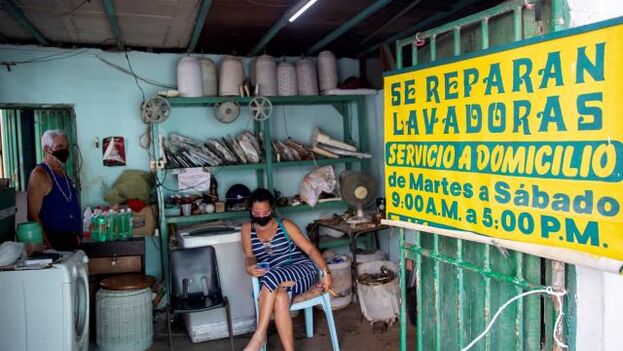
![]() 14ymedio, Madrid, 17 March 2023 — Cuban authorities were clear when they announced the creation of micro, small and medium-sized enterprises (SMEs) and non-agricultural cooperatives: the priority would be food production. The reality is that, despite the indication of preferentially authorizing these companies, only 15.3% (1,029) of the 6,704 created, up to the end of January, were involved in food. They were surpassed by gastronomic premises or supermarkets, grouped as food marketers, which with 1,273 reach 19% of the total and highlight the scarce contribution of private individuals to a state sector that has collapsed.
14ymedio, Madrid, 17 March 2023 — Cuban authorities were clear when they announced the creation of micro, small and medium-sized enterprises (SMEs) and non-agricultural cooperatives: the priority would be food production. The reality is that, despite the indication of preferentially authorizing these companies, only 15.3% (1,029) of the 6,704 created, up to the end of January, were involved in food. They were surpassed by gastronomic premises or supermarkets, grouped as food marketers, which with 1,273 reach 19% of the total and highlight the scarce contribution of private individuals to a state sector that has collapsed.
The services sector is confirmed as the leader among the new companies created on the Island, with 3,014 companies, some 45% of the total. “Other productions” comes in last at 21%, with 1,388 new businesses.
The data come from an analysis published this Friday by the official press in which the numbers for SMEs and non-agricultural cooperatives created through January 31, 2023 are broken down. On Thursday, more were added to a list currently composed of 7,225 businesses.
Among the most enigmatic data is that of employment. The figures indicate that 179,317 jobs were created, a figure celebrated by the report, which indicates that “development will tell if they are more or less than those required by each business or project. In any case, it is relevant for bringing in family income.”
However, to know the scope of this data it would be necessary to know how many of those jobs have been deducted from self-employment, since 3,310 of these new entities are repurposed self-employed businesses. The scale, in this sense, is balanced, since there are already 2,302 newly created jobs, when initially they were a small percentage.
The most prominent data indicate that only 42 of these businesses are engaged in exports — always through a state entity. This is even more serious if you take into account that last year when there were only 1,286 SMEs, there were already 32 that did business abroad. The exponential growth of authorized enterprises is not reflected in their contribution to the foreign sector.
By province, and as expected, Havana is ahead as a center for new initiatives, of which 2,631 are private, 43 are state and 24 are private cooperatives. The western area of the Island accounts for 62% of these businesses. Granma province has 608 private, 6 state and 5 private cooperatives, and is the province that has the most, although it is a great distance from Havana. Santiago de Cuba, Holguín and Matanzas now have around 400.
“There are fewer in Artemisa and Sancti Spíritus. The concentration of SMEs and non-agricultural cooperatives is observed in the capitals,” says the report, which highlights the importance of the 1,080 local development projects — mostly located in the center of the Island — which, in its opinion, “can increase the supply of goods and services to the population; in particular, of food.
Although the authors of the text — Doctor of Science Victoria Pérez Izquierdo and a work culture research team from the Cuban Institute of Anthropology — tend to be optimistic when pointing out that the dizzying increase in “economic actors occurs despite an unfavorable economic context, which affects access to basic inputs for the development of enterprises,” their doubts are visible.
“The questions would be,” they conclude, “when will these actors generate greater availability of food in the medium term? What obstacles do they have today in the production and sale of their goods and services? What can be transformed or modified so that these actors can increase their productive results?”
Cubadebate believes that the data reveal the need for a “better articulation” of new SMEs, as well as increasing their access to the foreign exchange market, lessening bureaucracy and designing public policies for international trade, among other steps.
The optimism generated by the timid openness to the private sector through micro, small and medium-sized enterprises has been drifting among the population and the entrepreneurs, who themselves fear or are suspicious of those who manage to create a prosperous business, since their proximity to the Government is systematically perceived.
A report by Cuba Siglo 21, a center based in Miami, entitled “Entrepreneurship in Cuba suffocated by Gaesa,” describes the SME law as “false openness,” which has served to “drown” the private sector that was beginning to emerge on the Island after the reforms of Raúl Castro, to create a kind of caste that is close to the regime, to attract foreign investment and facilitate a new rapprochement with the United States.
The same organization pointed out in January that the meetings between the Governments of Cuba and Russia confirm that the transition from a “model with a nationalized economy” to the “Russian mafia market” scheme is being implemented.
Translated by Regina Anavy
____________
COLLABORATE WITH OUR WORK: The 14ymedio team is committed to practicing serious journalism that reflects Cuba’s reality in all its depth. Thank you for joining us on this long journey. We invite you to continue supporting us by becoming a member of 14ymedio now. Together we can continue transforming journalism in Cuba.
